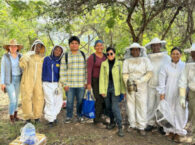Conservation Planning
Metrics
Community
Dane CountyCommunity Size
44,411University
University of Wisconsin - MadisonProgram
UniverCity YearCase Type
Project StoriesFocus Areas
EquityDiscipline
Environmental StudiesRegion
EPA Region 5, USAUniversity Department Code
Earth and Environmental SciencesSustainable Development Goals
06 Clean Water and SanitationPopulation Type
Business Owners and ConsumersIn an effort to reduce the amount of phosphorus in the Rock River Basin throughout Dane County, the Wisconsin Department of Natural Resources (WDNR) and U.S. Environmental
Protection Agency (EPA) concerted an effort to select several target areas most vulnerable to
pollution from phosphorus and other contributing factors of ecosystem degradation. Due to the
concentration of agricultural land around the Door Creek valley, accounting for approximately
48% of the total land use, it was identified as one of the sub-watersheds with the highest
agricultural phosphorus contributions to the Yahara River Watershed (Door Creek Watershed
Management Action Plan, 2016). However, agricultural contamination was only one factor
threatening the health of this ecosystem, the growth of residential development areas around
the area, amounting to 10%, has also presented several issues as well (Door Creek Watershed
Management Action Plan, 2016).
Extensive research on the levels of phosphorus has already begun within this project, and our
goal with this conservation plan is to build upon addressing the phosphorus issue and expand to
working to protect Door Creek from that and other main contributing factors to the loss of
biodiversity in this ecosystem.
For this project, we have identified three main targets to address the issue. The first target is
the aquatic species that live within Door Creek, we will measure the health of this target by the
biotic index of the macroinvertebrates that currently reside within the creek. The second target
is the Door Creek ecosystem, meaning the chemical composition and purity of the water, which
will be indicated by the level of algae within Lake Kegonsa, the outlet body of water for Door
Creek. Finally, our last target is the riparian buffer that surrounds Door Creek, which will be
identified by the total amount of ground cover and the proportion of native versus invasive
species of plants located within the buffer. The main threats to these targets include climate
change, phosphorus runoff, invasive species, and pollution.
This will be an important effort, not only to the native flora and fauna of Door Creek, but also
the the residents who live in the area and enjoy the recreational and health benefits that it
provides to them.
Residential development and agriculture in and around the Door Creek watershed pose a direct
threat to the biological diversity and water quality of the creek. Sustainable practices and
proper management are vital to the health of the ecosystem, as the future of Door Creek relies
on a concerted effort between Dane County and landowners of the Door Creek watershed.
Read the final student report delivered to the local gov/community partner.
UniverCity Year Contact Info
Gavin Luter
Managing Director
gavin@cows.org
608-261-1141
University Faculty Contact
Arlyne Johnon
Environmental Studies
ajohns10@wisc.edu
Local Government / Community Contact
Lauren Kuhl
Legislative Management System Specialist
Kuhl.Lauren@countyofdane.com


